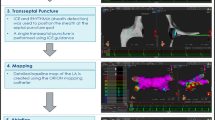Abstract
Introduction
Ablations requiring transseptal access to the left heart place patients at increased risk for stroke, bleeding, and post-procedural cognitive dysfunction and other complications. Diminishing left atrial catheter dwelling time may decrease these risks. 3-D NavX can be used to facilitate reaccess of transseptal puncture sites to allow catheter removal from the left atrium immediately after ablation, with reaccess through the prior transseptal site if required. Here, we describe the techniques employed and our experience using 3-D NavX to limit left atrial catheter dwelling time by marking and reaccess of the left atrium via the previously marked transseptal puncture site, a potentially radiation-free technique.
Methods
With the use of 3-D NavX, a right atrial geometry is created. The patent foramen ovale is marked by using a standard EP catheter, or the transseptal puncture site is marked using 3-D NavX by creating a unipolar electrode on the transseptal needle at the time of puncture and at the time of catheter withdrawal of the ablation catheter from the left atrium. Marking the access site allows the catheter to be removed from the left side of the heart immediately after the ablation. If reaccess to the left atrium is required, the previously marked transseptal site is used to navigate the ablation catheter to reaccess the left atrium. All patients <30 years who had undergone this technique were evaluated. Data gathered included patient demographics, need for and success of transseptal reaccess, left atrial catheter dwelling time, and complications.
Results
The transseptal site was marked by 3-D NavX in 54 patients. We were able to successfully reaccess the transseptal puncture site using 3-D guidance in all 10 patients where it was desired. In these 54 patients, the complication rate was low with one small post-procedural pulmonary embolism and one right bundle branch block. No other complications were noted. The median procedure time was 105 min (range 58–446 min), the median total fluoroscopic time for the entire procedure was 1.3 min (range 0.0–30.8 min), and the median left-sided catheter dwelling time was 21 min (range 6–112 min).
Conclusions
In our retrospective review, reaccess of transseptal puncture site was reproducible, and early removal of the catheter from the left side was without the need for repeat transseptal punctures. This technique decreases the time the catheter dwells in the left atrium, which could decrease risks such as clotting, bleeding, and cognitive dysfunction.

Similar content being viewed by others
Abbreviations
- AET:
-
Automatic ectopic tachycardia
- AF:
-
Atrial fibrillation
- ASD:
-
Atrial septal defect
- AVRT:
-
Atrioventricular reentrant tachycardia
- EP:
-
Electrophysiology
- HRA:
-
High right atrium
- IART:
-
Intra-atrial reentrant tachycardia
- ICE:
-
Intra-cardiac echocardiogram
- LA:
-
Left atrium
- POCD:
-
Post-procedural cognitive dysfunction
- RA:
-
Right atrium
- RF:
-
Radiofrequency
- RVA:
-
Right ventricular apex
- TEE:
-
Transesophageal echocardiogram
- TSP:
-
Transseptal puncture
- VT:
-
Ventricular tachycardia
References
Roelke, M., Smith, A. J., & Palacios, I. F. (1994). The technique and safety of transseptal left heart catheterization: the Massachusetts General Hospital experience with 1,279 procedures. Catheterization and Cardiovascular Diagnosis, 32, 332–339.
De Ponti, R., Cappato, R., Curnis, A., Della Bella, P., Padeletti, L., Raviele, A., Santini, M., et al. (2006). Trans-septal catheterization in the electrophysiology laboratory: data from a multicenter survey spanning 12 years. Journal of the American College of Cardiology, 47, 1037–1042.
Law, I. H., Fischbach, P. S., LeRoy, S., Lloyd, T. R., Rocchini, A. P., & Dick, M. (2001). Access to the left atrium for delivery of radiofrequency ablation in young patients: retrograde aortic vs transseptal approach. Pediatric Cardiology, 22(3), 204–209.
Gaita, F., Caponi, D., Pianelli, M., et al. (2010). Radiofrequency catheter ablation of atrial fibrillation: a cause of silent thromboembolism? Magnetic resonance imaging assessment of cerebral thromboembolism in patients undergoing ablation of atrial fibrillation. Circulation, 122, 1667–1673.
Medi, C., Evered, L., Silbert, B., et al. (2013). Subtle post-procedural cognitive dysfunction after atrial fibrillation ablation. Journal of the American College of Cardiology, 62, 531–539.
Kugler, J. D., Danford, D. A., Houston, K. A., & Felix, G. (2002). Pediatric radiofrequency catheter ablation registry success, fluoroscopy time, and complication rate for supraventricular tachycardia: comparison of early and recent eras. Journal of Cardiovascular Electrophysiology, 13(4), 336–341.
Author information
Authors and Affiliations
Corresponding author
Rights and permissions
About this article
Cite this article
Unnithan, A.G., Dexter, B.C., Law, I.H. et al. Limiting left-sided catheter dwelling time using 3-D NavX to mark and reaccess the left atrium via prior transseptal puncture site. J Interv Card Electrophysiol 40, 125–128 (2014). https://doi.org/10.1007/s10840-014-9906-y
Received:
Accepted:
Published:
Issue Date:
DOI: https://doi.org/10.1007/s10840-014-9906-y




